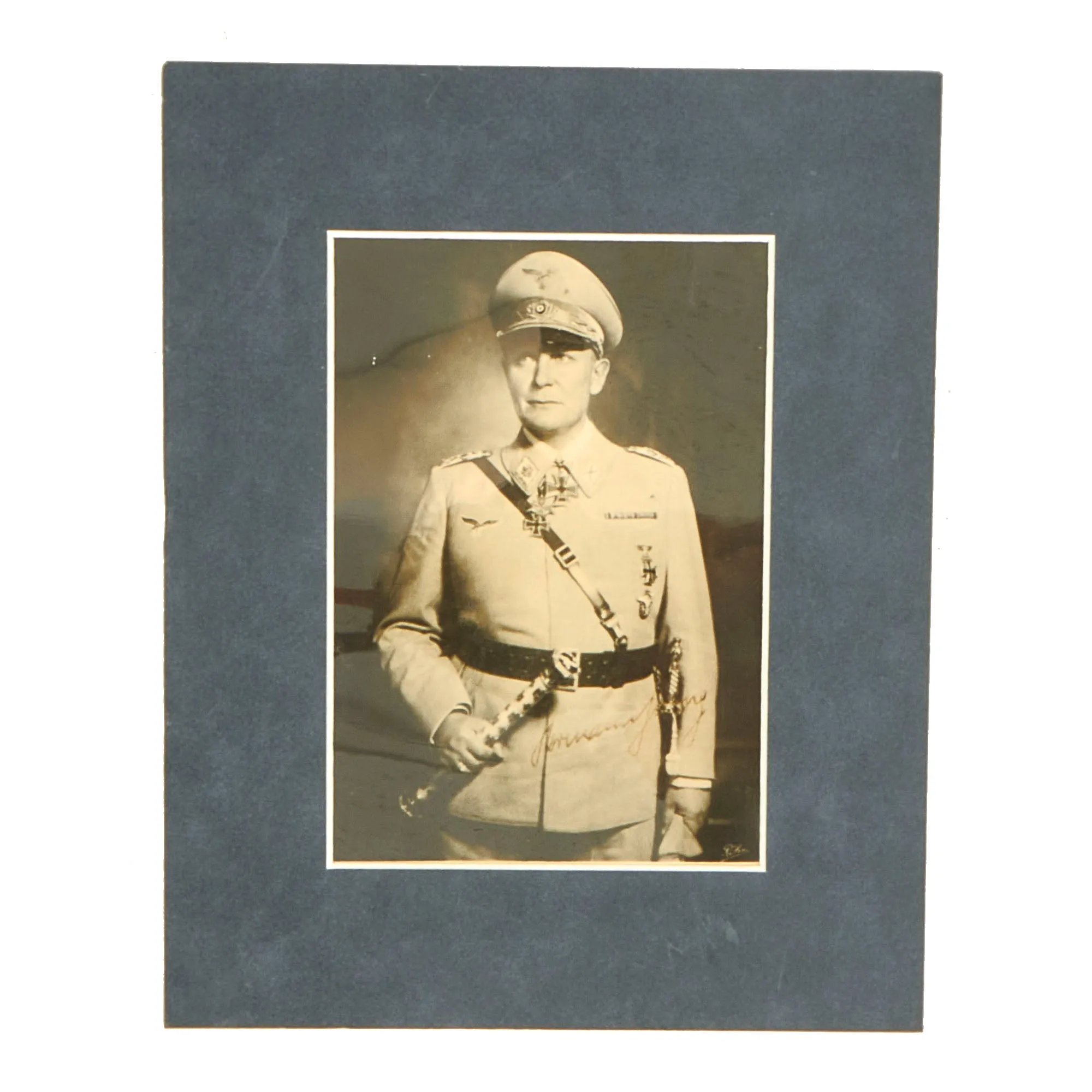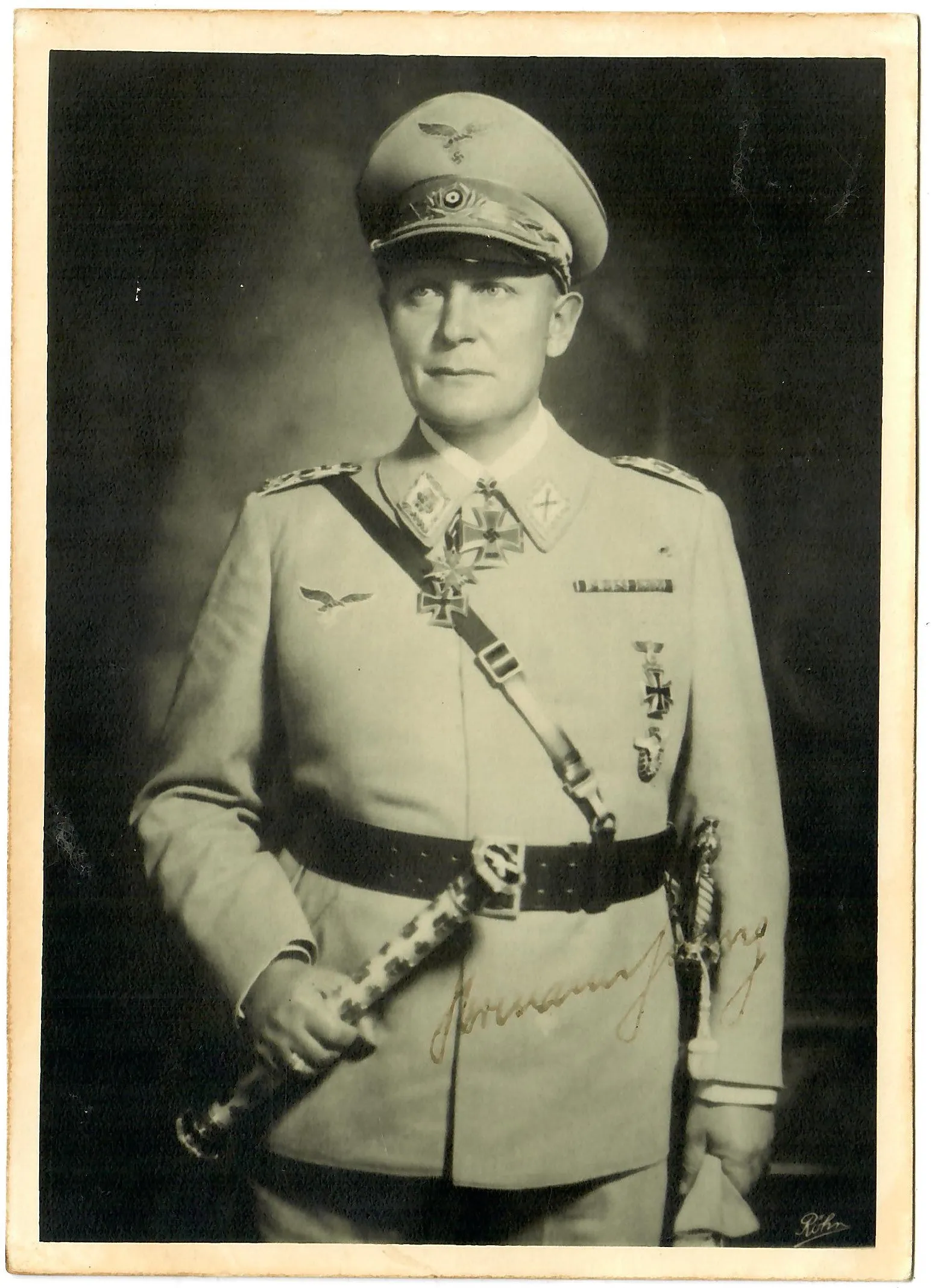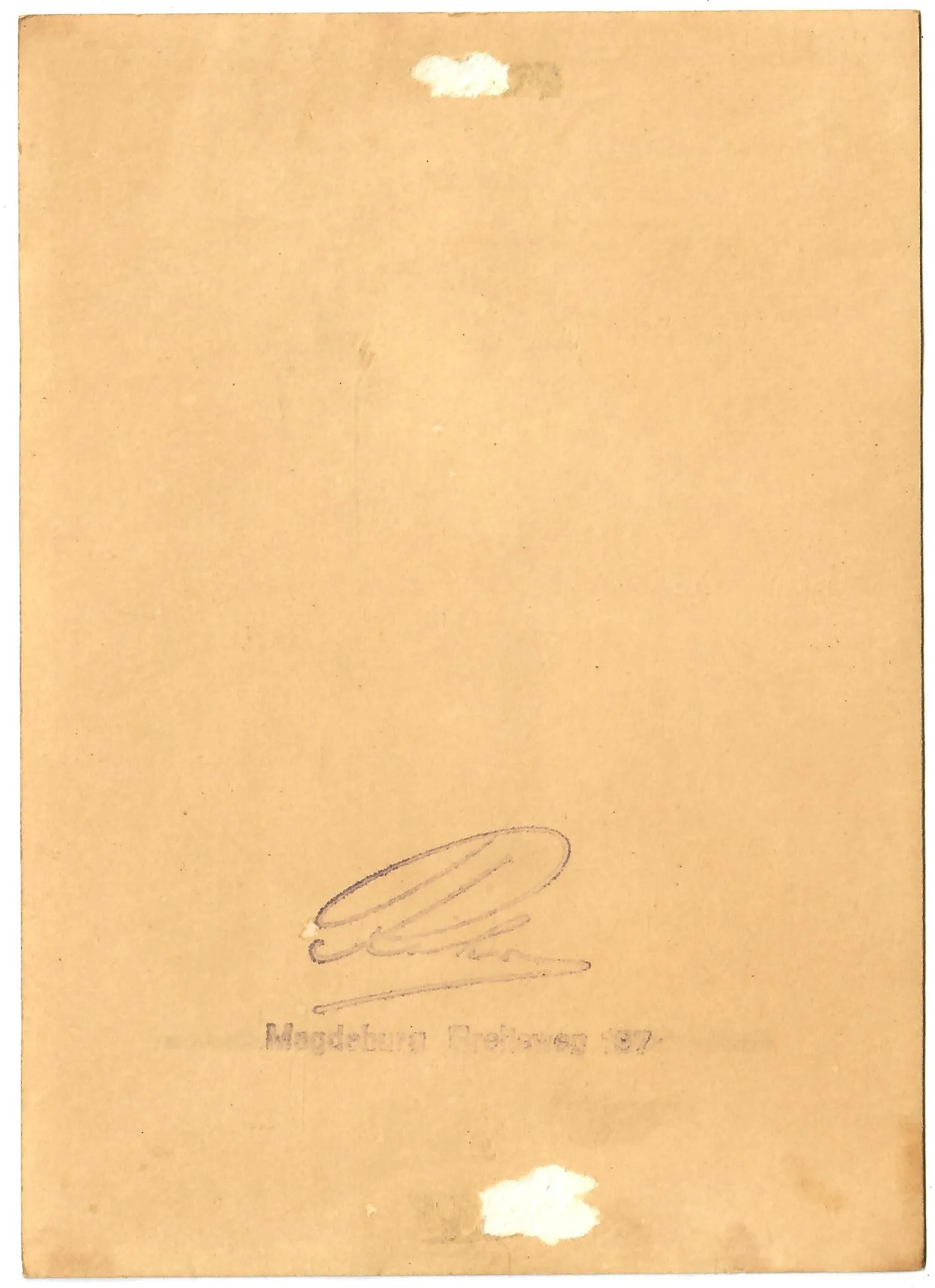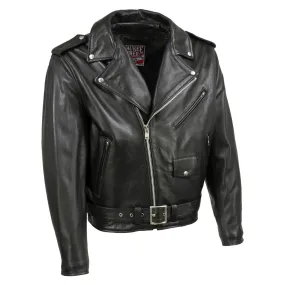Original Item: Only One Available. Here we have a very nice signed German WWII period Photograph of the Military Leader and Convicted War Criminal, Reichsmarschall Hermann Göring. Originally the head of just the Luftwaffe, he was promoted to Reichsmarschall after the successful invasion of France, which was a rank over Feldmarschall, created especially for him to placate his need for glory, and to show that he was senior to all other Wehrmacht leaders. New insignia were created for this special rank, which Göring quickly adopted and had fitted to his uniforms.
This signed photograph was taken after 1940, when he received the promotion, and it shows the correct "Crossed Baton" devices on his left collar. We can also somewhat see the more ornate shoulder boards that were used by the rank. Göring looks to be wearing a light gray uniform with a white shirt in the photograph, and is holding a Field Marshal's baton. He is also wearing his 1939 Grand Cross of the Iron Cross, which he was given in the same ceremony as his promotion, and he was the only person to be awarded this during WWII.
The photograph measures 5" x 7", and is marked on the back with a printer's logo over the address Magdeburg Breiteweg 187. It is contained in a plastic sleeve, which has been matted for framing with an 8" x 10" surround. There is Hermann Göring's signature written across the lower portion of his uniform tunic. We have compared the signature to many other known examples, and it is a match.
A very nice signed photograph of one of the most powerful men in the Third Reich, if not the most conceited of all the NSDAP leadership. Ready to display!
Hermann Wilhelm Göring (or Goering 12 January 1893 – 15 October 1946) was a German politician, military leader and convicted war criminal. He was one of the most powerful figures in the NSDAP Party, which ruled Germany from 1933 to 1945.
A veteran World War I fighter pilot ace, Göring was a recipient of the Pour le Mérite ("The Blue Max"). He was the last commander of Jagdgeschwader 1 (JG I), the fighter wing once led by Manfred von Richthofen. An early member of the NSDAP Party, Göring was among those wounded in A H's failed Beer Hall Putsch in 1923. While receiving treatment for his injuries, he developed an addiction to morphine which persisted until the last year of his life. After AH became Chancellor of Germany in 1933, Göring was named as minister without portfolio in the new government. One of his first acts as a cabinet minister was to oversee the creation of the Gestapo, which he ceded to Heinrich Himmler in 1934.
Following the establishment of the NSDAP state, Göring amassed power and political capital to become the second most powerful man in Germany. He was appointed commander-in-chief of the Luftwaffe (air force), a position he held until the final days of the regime. Upon being named Plenipotentiary of the Four Year Plan in 1936, Göring was entrusted with the task of mobilizing all sectors of the economy for war, an assignment which brought numerous government agencies under his control. In September 1939, A H designated him as his successor and deputy in all his offices. After the Fall of France in 1940, he was bestowed the specially created rank of Reichsmarschall, which gave him seniority over all officers in Germany's armed forces.
By 1941, Göring was at the peak of his power and influence. As the Second World War progressed, Göring's standing with A H and with the German public declined after the Luftwaffe proved incapable of preventing the Allied bombing of Germany's cities and resupplying surrounded Axis forces in Stalingrad. Around that time, Göring increasingly withdrew from military and political affairs to devote his attention to collecting property and artwork, much of which was stolen from Jewish victims of the war crimes. Informed on 22 April 1945 that A H intended to commit suicide, Göring sent a telegram to A H requesting his permission to assume leadership of the Reich. Considering his request an act of treason, A H removed Göring from all his positions, expelled him from the party, and ordered his arrest. After the war, Göring was convicted of conspiracy, crimes against peace, war crimes and crimes against humanity at the Nuremberg trials in 1946. He was sentenced to death by hanging, but committed suicide by ingesting cyanide hours before the sentence was to be carried out.
Deutsche Reichsbahn (1937 to 1945)
With the Act for the New Regulation of the Conditions of the Reichsbank and the Deutsche Reichsbahn (Gesetz zur Neuregelung der Verhältnisse der Reichsbank und der Deutschen Reichsbahn) of 10 February 1937 the Deutsche Reichsbahn Gesellschaft was placed under Reich sovereignty and was given the name Deutsche Reichsbahn.
World War II and military use
The Reichsbahn had an important logistic role in supporting the rapid movement of the troops of the Wehrmacht, for example:
In all the occupied lands the Reichsbahn endeavored to incorporate the captured railways (rolling stock and infrastructure) into their system. Even towards the end of the war the Reichsbahn continued to move military formations. For example, in the last great offensive, the Battle of the Bulge (from 16 December 1944), tank formations were transported from Hungary to the Ardennes.
The railways managed by the "Eastern Railway Division" (Generaldirektion der Ostbahn) were initially run from that part of the Polish State Railways within the so-called General Government gelegene Teil der Polnischen Staatsbahnen (PKP), but from November 1939 by the Ostbahn (Generalgouvernement).
In the campaigns against Poland, Denmark, France, Yugoslavia, Greece etc. the newly acquired standard gauge networks could be used without difficulty. By contrast, after the start of the invasion of Russia on 22 June 1941, the problem arose of transferring troops and materiel to Soviet broad gauge lines or converting them to German standard gauge. Confounding German plans, the Red Army and Soviet railways managed to withdraw or destroy the majority of its rolling stock during its retreat. As a result, German standard gauge rolling stock had to be used for an additional logistic role within Russia; this required the laying of standard gauge track. The price was high: Reichsbahn railway staff and the railway troops of the Wehrmacht had to convert a total of 16,148 kilometres of Soviet trackage to German standard gauge track between 22 June and 8 October 1941.
During the war, locomotives in the war zones were sometimes given camouflage livery. In addition, locomotives were painted with the Hoheitsadler symbol (the eagle, Germany's traditional symbol of national sovereignty) holding a swas. On goods wagons the name "Deutsche Reichsbahn" was replaced by the letters "DR". Postal coaches continued to bear the name "Deutsche Reichspost".
The logistics of the Reichsbahn were crucial to the conduct of Germany's military offensives. The preparations for the invasion of Russia saw the greatest troop deployment by rail in history.
Expansion
Characteristic of the first six and a half years of this period was the exponential growth of the Deutsche Reichsbahn, which was almost exclusively due to the takeover of other national railways. This affected both parts of foreign state railways (in Austria the entire state railway) in the countries annexed by the Deutsche Reich, as well as private railways in Germany and in other countries:
The logistics of the Reichsbahn were also an important factor during the Shoah. Jews were transported like cattle to the contingent and extermination camps by the Deutsche Reichsbahn in trains of covered goods wagons, so-called Shoah trains. These movements using cattle wagons, for example, from the goods station of the great Frankfurt Market Hall thus played a significant role in the genocide within the extermination machinery of the Shoah.
Breakup of the Reichsbahn
With the end of the Second World War in 1945 those parts of the Deutsche Reichsbahn that were outside the new German borders laid down in the Potsdam Agreement were transferred to the ownership and administration of the states in whose territory they were situated. For example, on 27 April 1945, the Austrian railways became independent again as the Austrian State Railway (Österreichische Staatseisenbahn or ÖStB), later renamed as the Austrian Federal Railways (Österreichische Bundesbahnen or ÖBB) on 5 August 1947.

















